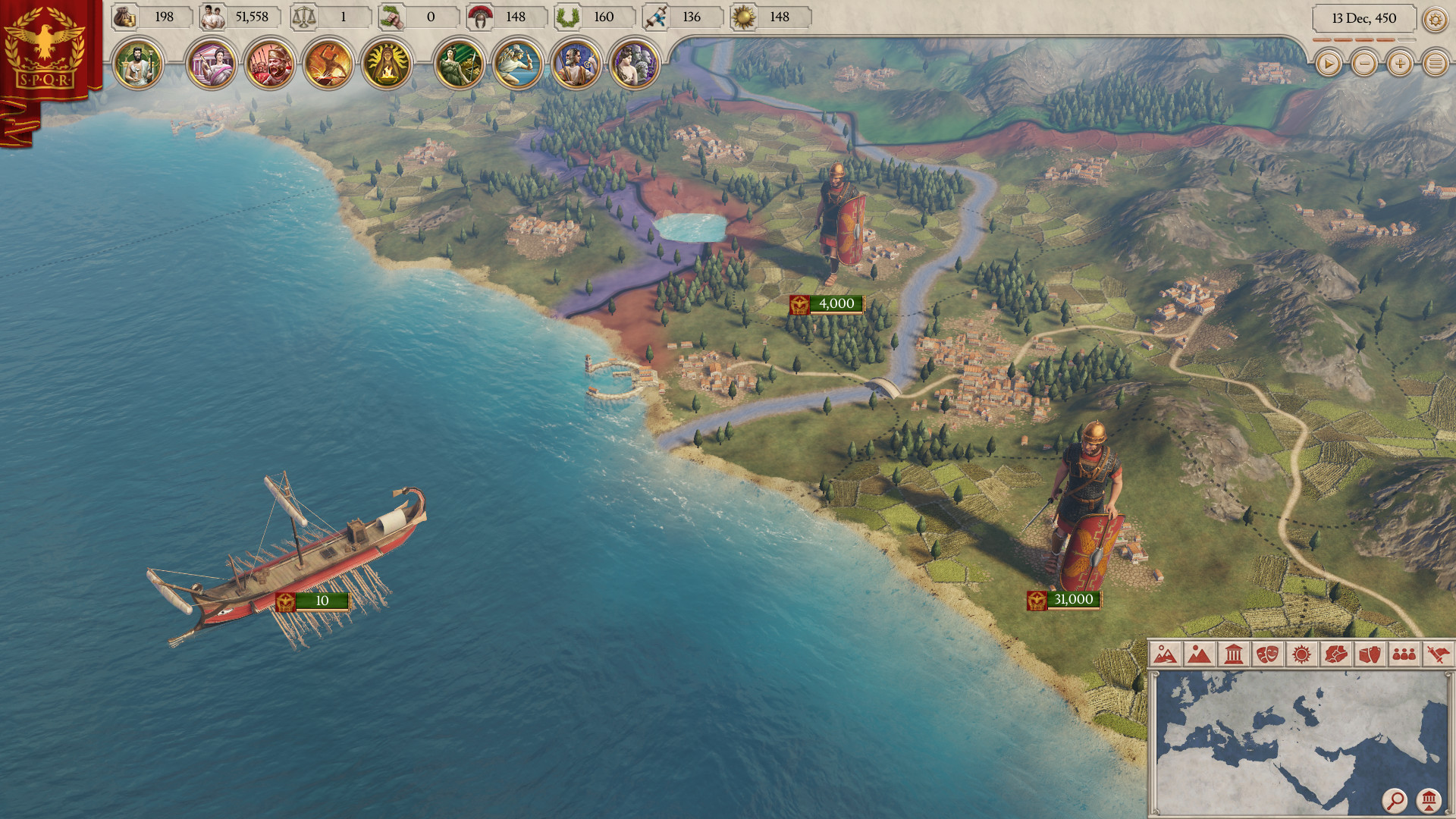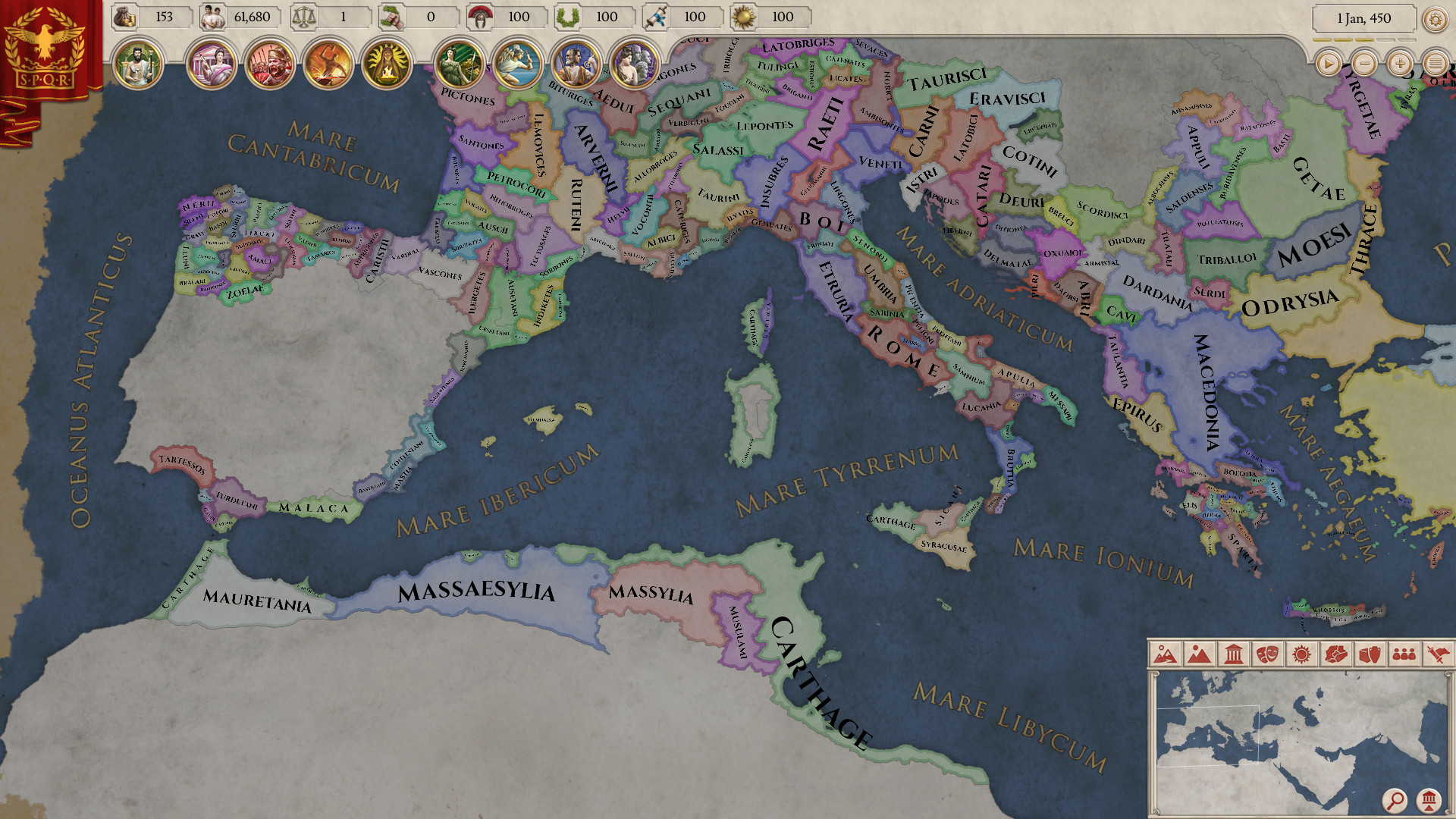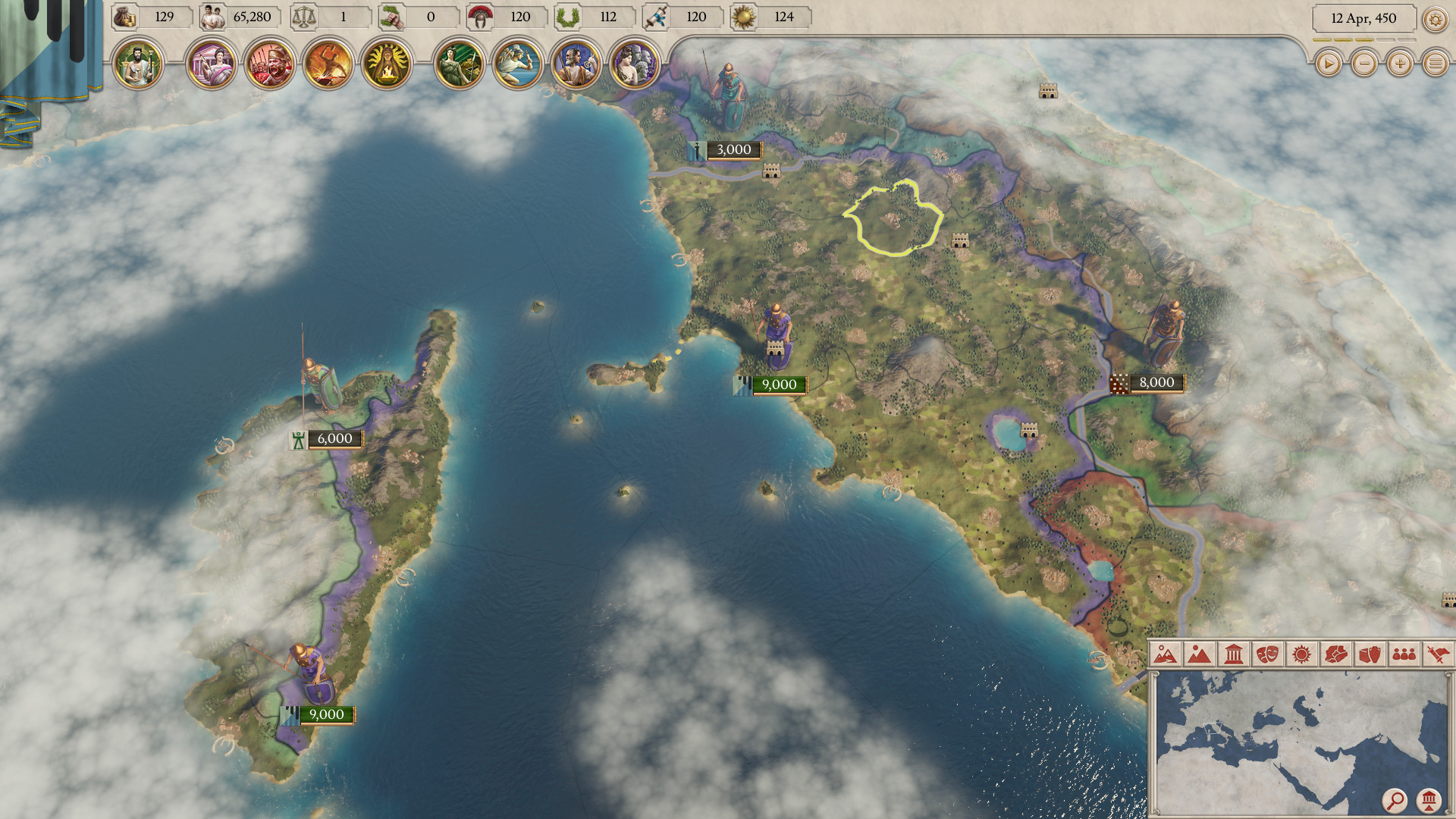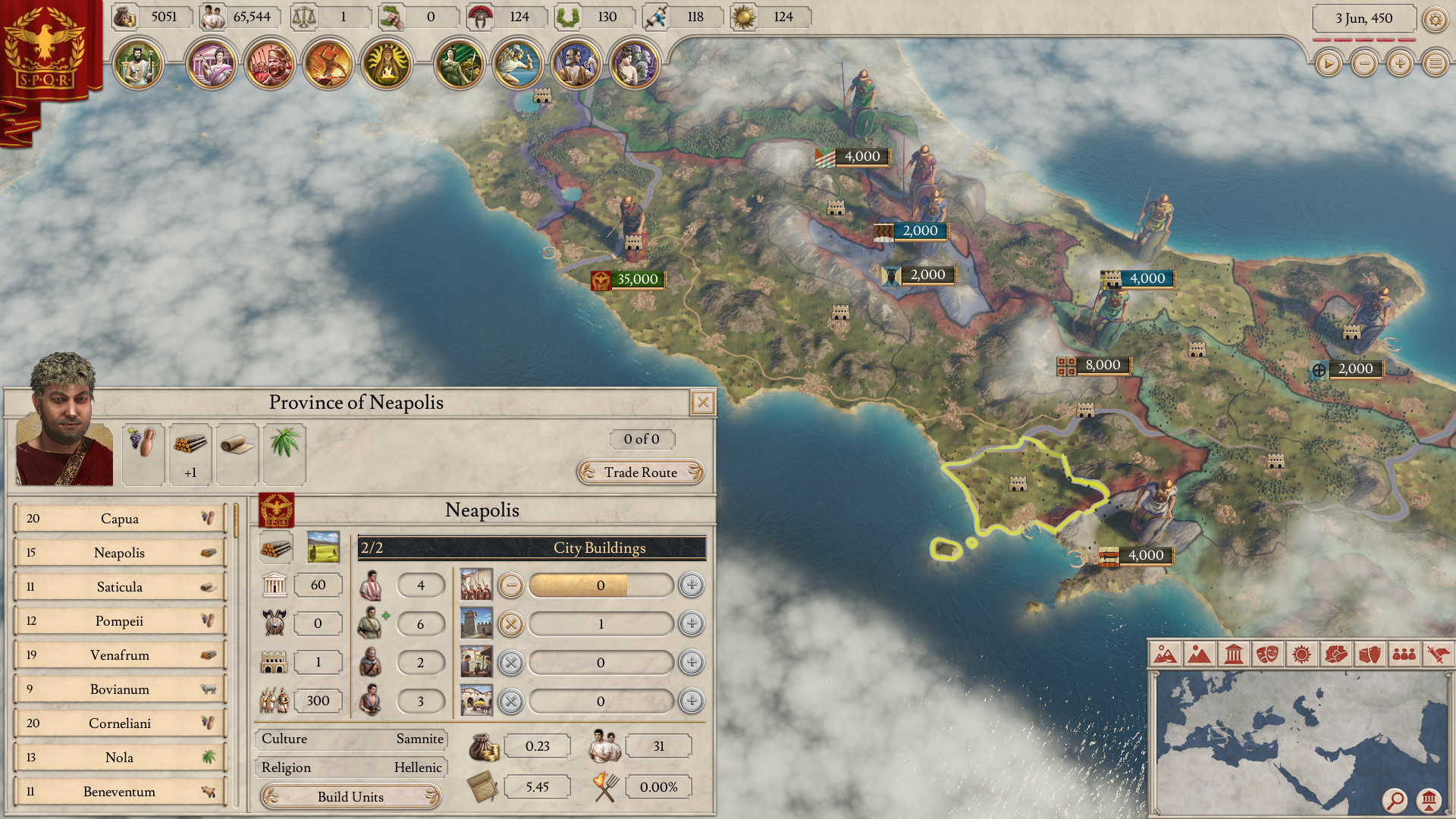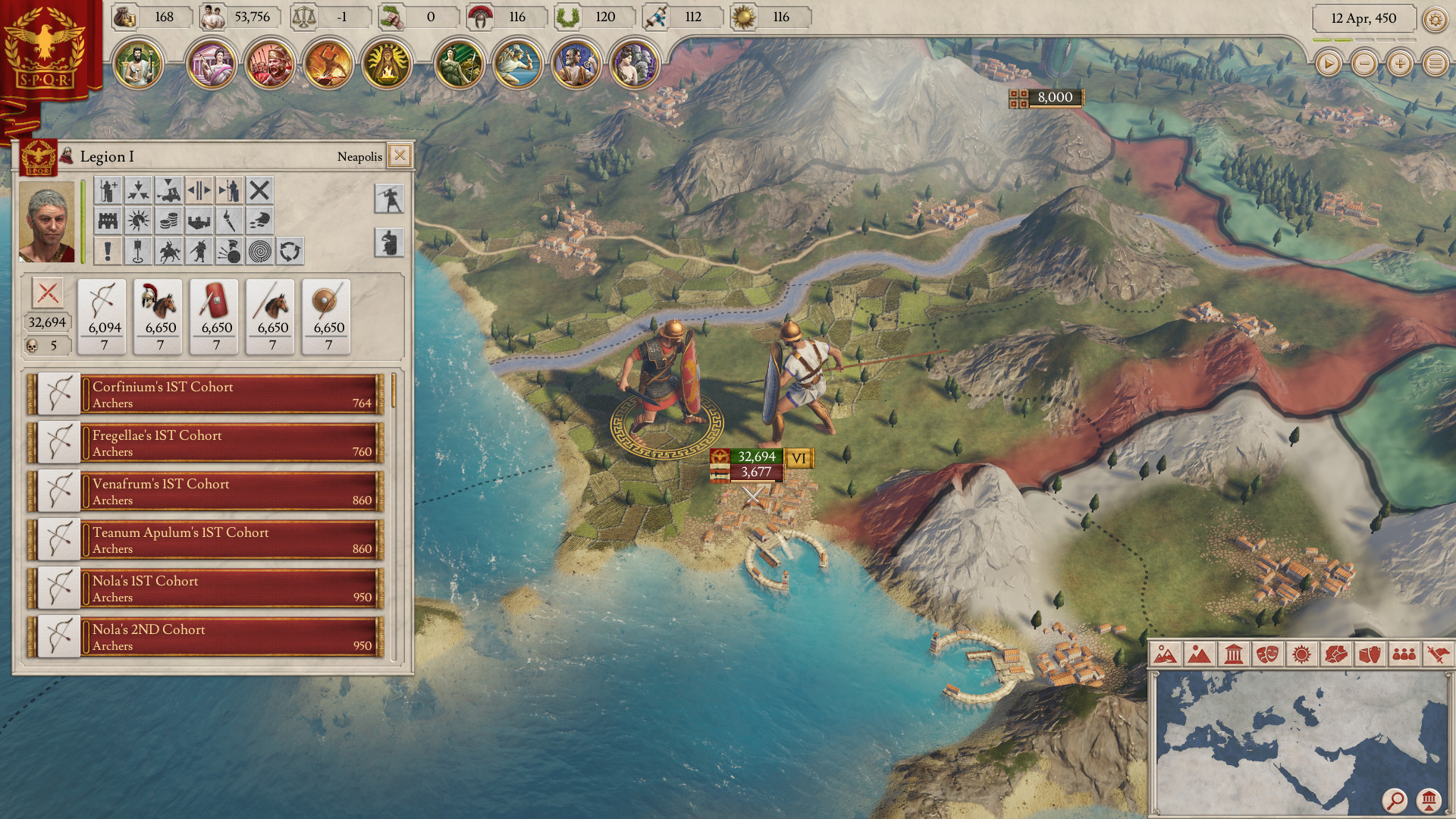Alexander. Hannibal. Caesar. These great men and dozens like them shaped the destiny of a continent. Mighty kings, clever generals and would-be gods made their mark on the ancient Mediterranean. Around this sea, close knit nations tested their mettle and virtue against each other in fierce combat, their cultural and political legacy now inseparable from what we understand as Western Civilization. But nothing was guaranteed. Can you change the course of history in Imperator: Rome?
Imperator: Rome is the newest grand strategy title from Paradox Development Studio. Set in the tumultuous centuries from Alexander’s Successor Empires in the East to the foundation of the Roman Empire, Imperator: Rome invites you to relive the pageantry and challenges of empire building in the classical era. Manage your population, keep an eye out for treachery, and keep faith with your gods.
Imperator: Rome is the newest grand strategy title from Paradox Development Studio. Set in the tumultuous centuries from Alexander’s Successor Empires in the East to the foundation of the Roman Empire, Imperator: Rome invites you to relive the pageantry and challenges of empire building in the classical era. Manage your population, keep an eye out for treachery, and keep faith with your gods.
Imperator: Rome’s features include:
Character Management:
A living world of characters with varying skills and traits that will change over time. They will lead your nation, govern your provinces and command your armies and fleets. We also introduce our new, more human-like character art.Diverse Populations:
Citizens, freemen, tribesmen and slaves - each population with its own culture and religion. Whether they fill your armies, fill your coffers or fill your colonies, keep an eye on their happiness - your success depends on their satisfaction.Battle Tactics:
Choose your approach before battle to counter the stratagems of your foes.Military Traditions:
Each culture has a unique way of waging war. Romans and Celts have different options available to them. Unlock unique bonuses, abilities and units.Different Government Types:
Manage the senate in a Republic, hold your court together in a monarchy, answer to the clans in a tribal system.Barbarians and Rebellions:
Migrating barbarians may sack or settle your best land, while disloyal governors or generals can turn against you - taking their armies with them!Trade:
Goods provide bonuses to their home province. Will you take advantage of stockpiles for local strength or trade excess goods to spread the wealth around?Provincial Improvement:
Invest in buildings, roads and defences to make your kingdom stronger and richer.
Development Diary #49 - Navies in Patch 1.1
While functional, especially for small engagements, we felt this system did not adequately reflect the realities of Hellenistic and Roman naval combat. What were these realities then?
Detailed accounts of naval battles from the era are actually somewhat sparse. Historically navies were made up by a great variety of different types of ships, with different roles. Normally ships from this era are classified by the number of rowers in one section used to propel them. A three (or Triere) is bigger than a two but smaller than a six (Hexere) and would be used for different purposes.
A directed naval battle would often involve galleys forming a line of battle, with the goal of preventing the opposing side from forcing through it. The primary ways for ships to engage were bombardment using arrows and artillery, boarding and ramming. Heavier ships would generally be taller, and harder to board. Ships heavier than 2s or 3s would also generally be Cataphract - covered - to protect from arrows.
Over time ships would grow bigger and bigger, especially in the confrontations between the big and very rich successor kingdoms in the eastern mediterranean. In the western mediterrenean ships would never be as big and with the ascendance of the Roman Empire the custom to build the bigger ships would be forgotten, with the battle of Actium generally being regarded as the end of the Big ship era.
At the start of our game however, and for most of the timeline the trend in the east was to build greater and greater ships, with some truly huge galleys seeing the day of light. The use for these enormous ships (with 10 sections of rowers or more) remains a point of discussion to this day, William M Murray argues that these behemoths of the sea were more useful for siege craft, used for naval assaults on the many ports of the Aegean, the Levant and Asia minor. Their big marine attachments, huge and very heavy high quality rams (a modern laboratory test concluded that the heavier rams in use in this era are impressive even in the light of modern engineering) used to capture ports, by forcing through floating barriers, as well as carrying full siege engines and catapults on board. The various ways to do the latter was something greek navies specialized in general in, with manuals written at the time for how to best conquer or defend a port by sea.
The super heavy ships (which in Imperator is considered to be anything above 8 sections of rowers) were never extremely common, but they did have a given place in the navies of the east and we have wanted to include them and their role, and so our rework is inspired by Murrays work.
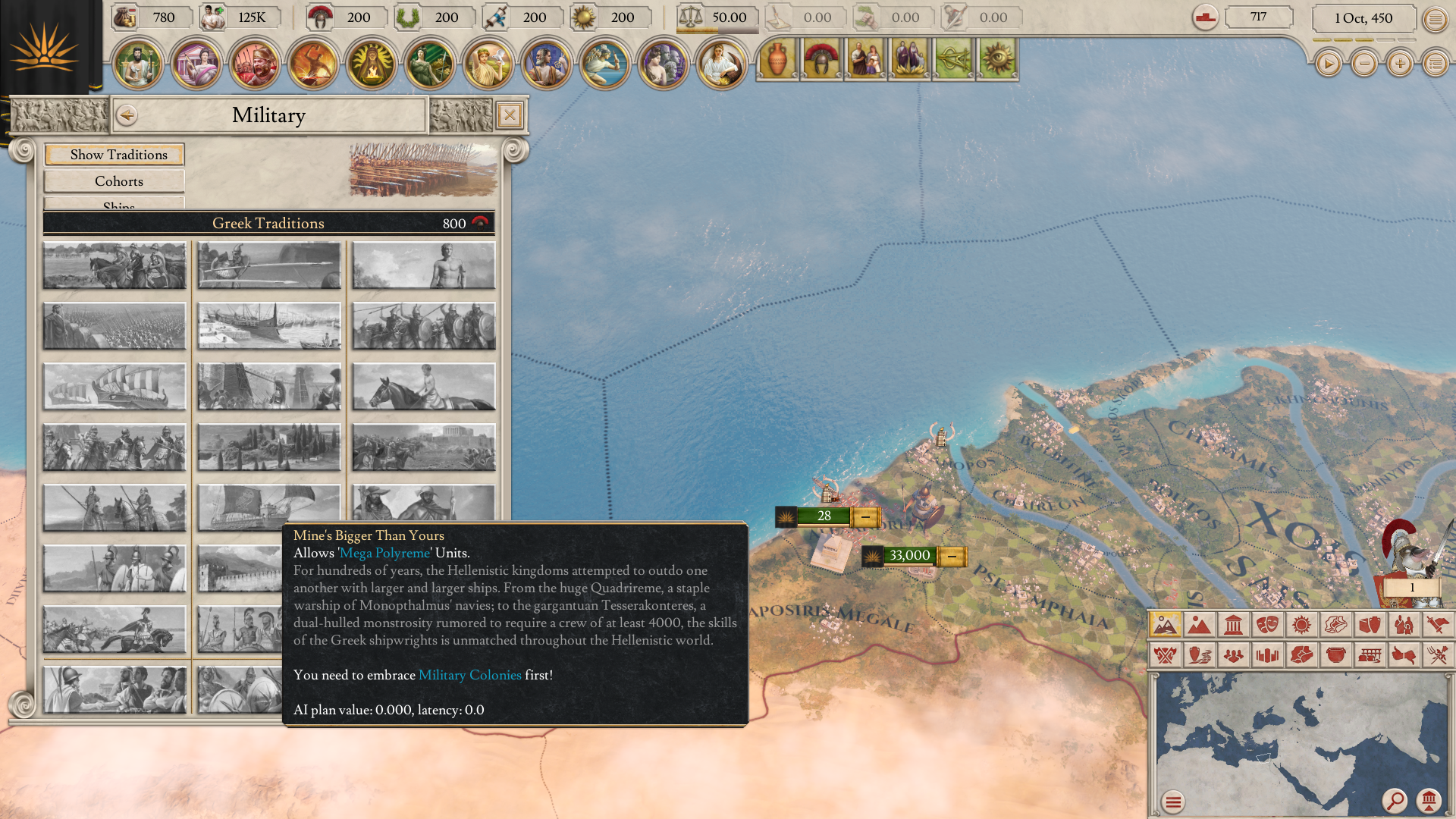
To better cover the variety and uses of navies will be forming a line of battle. As on land there will be a first row, a second row, and a flank. Ship types will be broken into 3 categories, and individual ship types will have strengths and weaknesses. Mainly the goal is to allow different roles for light and medium ships, based on their usage in the era.
Light ships have high maneuver, allowing them to target opposing ships much further from their position in the line of battle, and can deal more morale damage. Medium ships have less maneuver range but are instead more resistant to damage. The Wood trade good will now be considered to represent access to great amounts of high quality ship building wood and no longer be necessary for the lighter ships, since these should generally be buildable by the wood that would be available in most cities even if it was not their primary export. The medium ships however still require access to wood, and importing wood helps the quality of all ships produced.
Heavy ships (8s and 10s) will have a very limited maneuver (with the 10s just able to target the ship directly in front of them). While they can deal a great deal of strength damage, and probably easily sink any given ship in front of them, they are likely to be swarmed and sunk or even captured if fighting without support against a great number of lighter ships. Heavy ships will however have access to 3 unit abilities (more on that below) and since their niche use was more common in the eastern mediterrenean they will require unlocking via military traditions. Traditions that do not unlock heavy ships will instead strengthen the use of lighter and medium ships.
Lastly when possible ships will make use of cultural names, a Greek bireme will for instance go by the name of Lembos while an Illyrian or even Roman will be called a Liburnian.
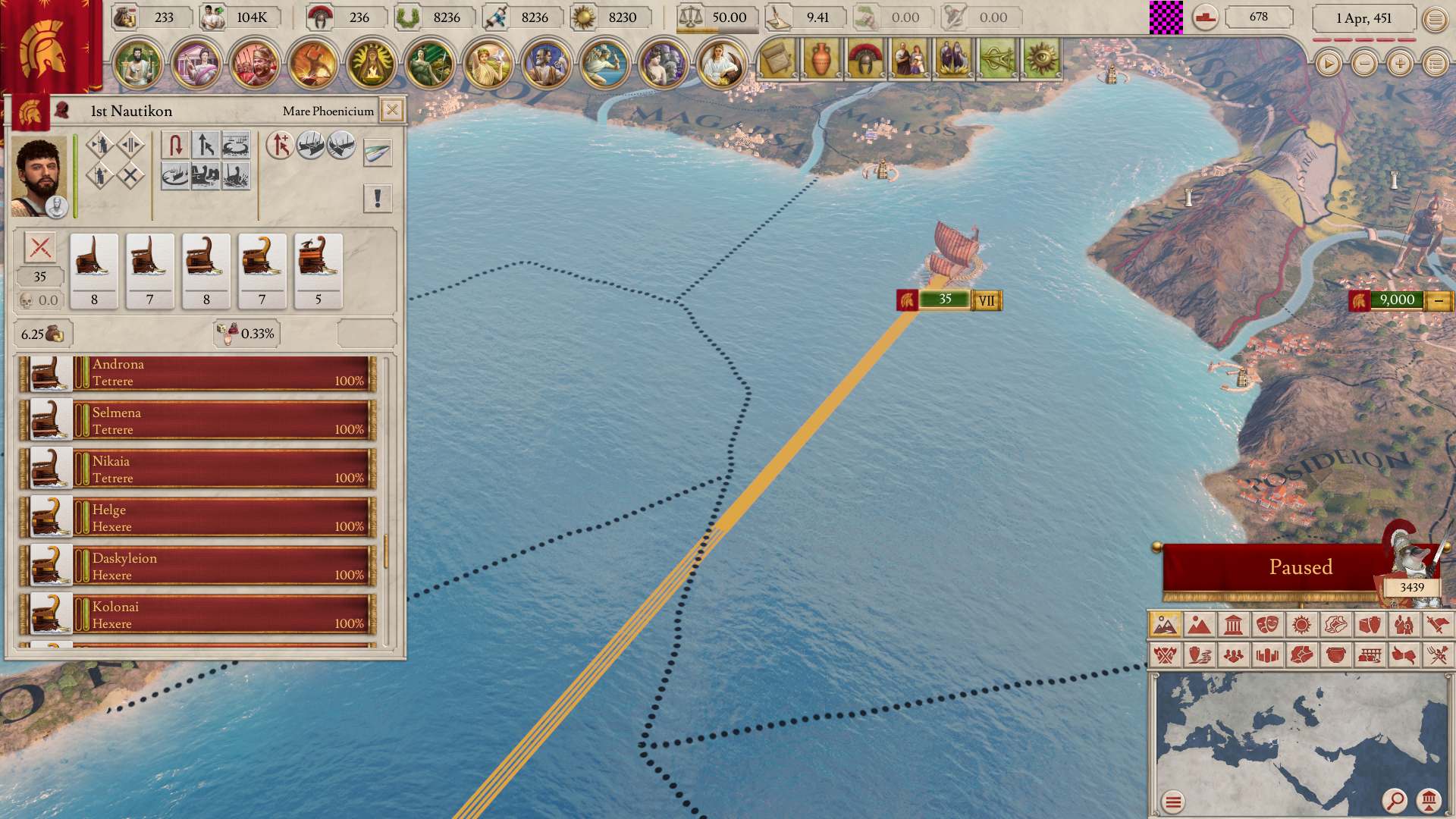

[h1]Capturing ships
[/h1]
When a ship reaches 0 morale while not yet being at 0 strength there is a chance it will be captured. Capture chance will be based on the type of ship that was targeting the removed ship and the removed ship itself. Mediums and heavies have slightly higher chances to capture lighter ships, but since lighter ships deal more morale damage they will get more chances to capture ships overall. A fleet of only light ships is far more likely to take a higher number of prizes in any given battle.
A captured ship is still removed from battle but will be added to the opposing navy that the capturing ship belonged to.
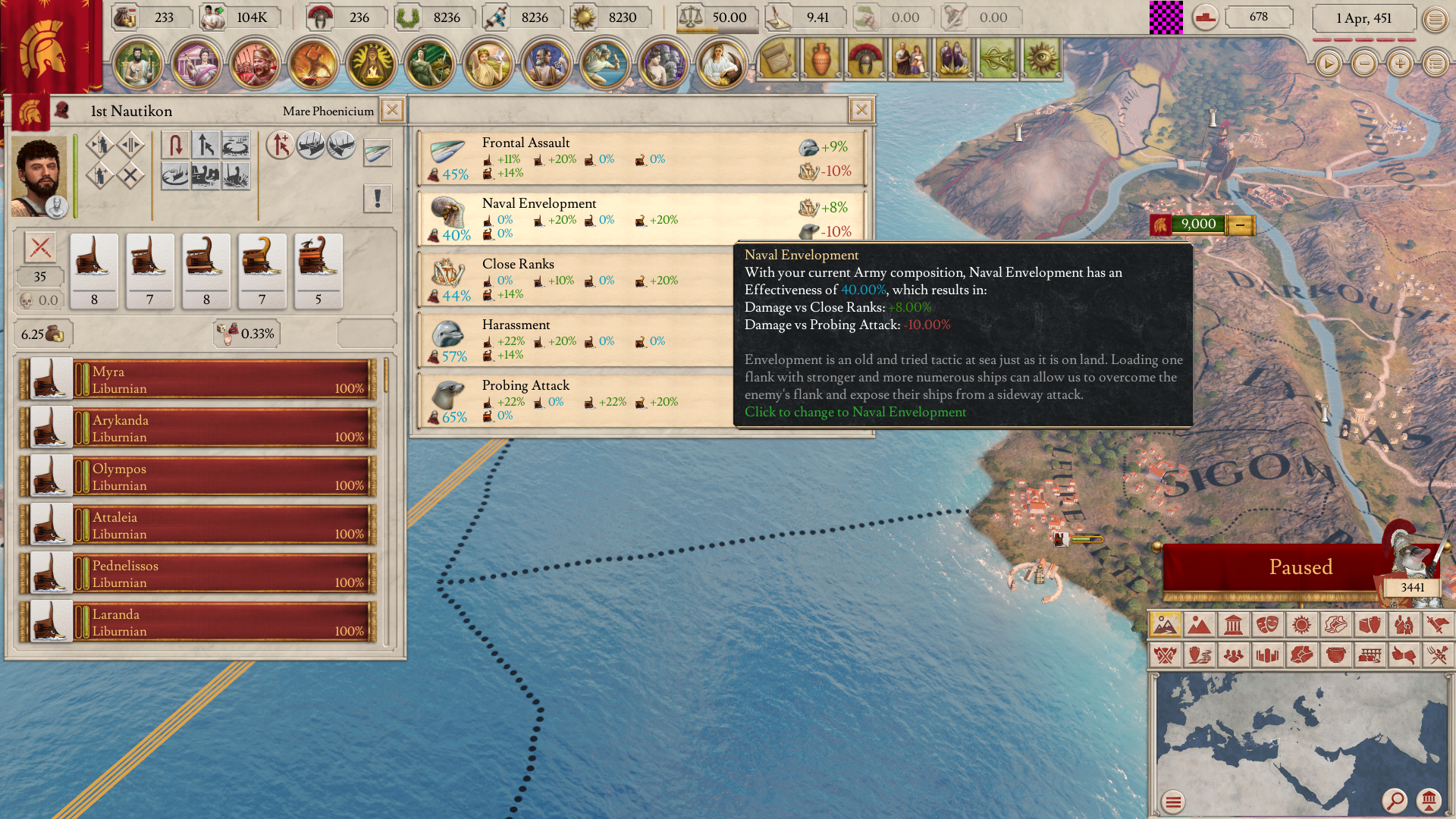
With more ship types available the Tactics system is going to be used at sea as well. Depending on your composition different tactics will have varying efficiency. Choice of tactic can also affect how likely the battle is to result in the capture of ships.
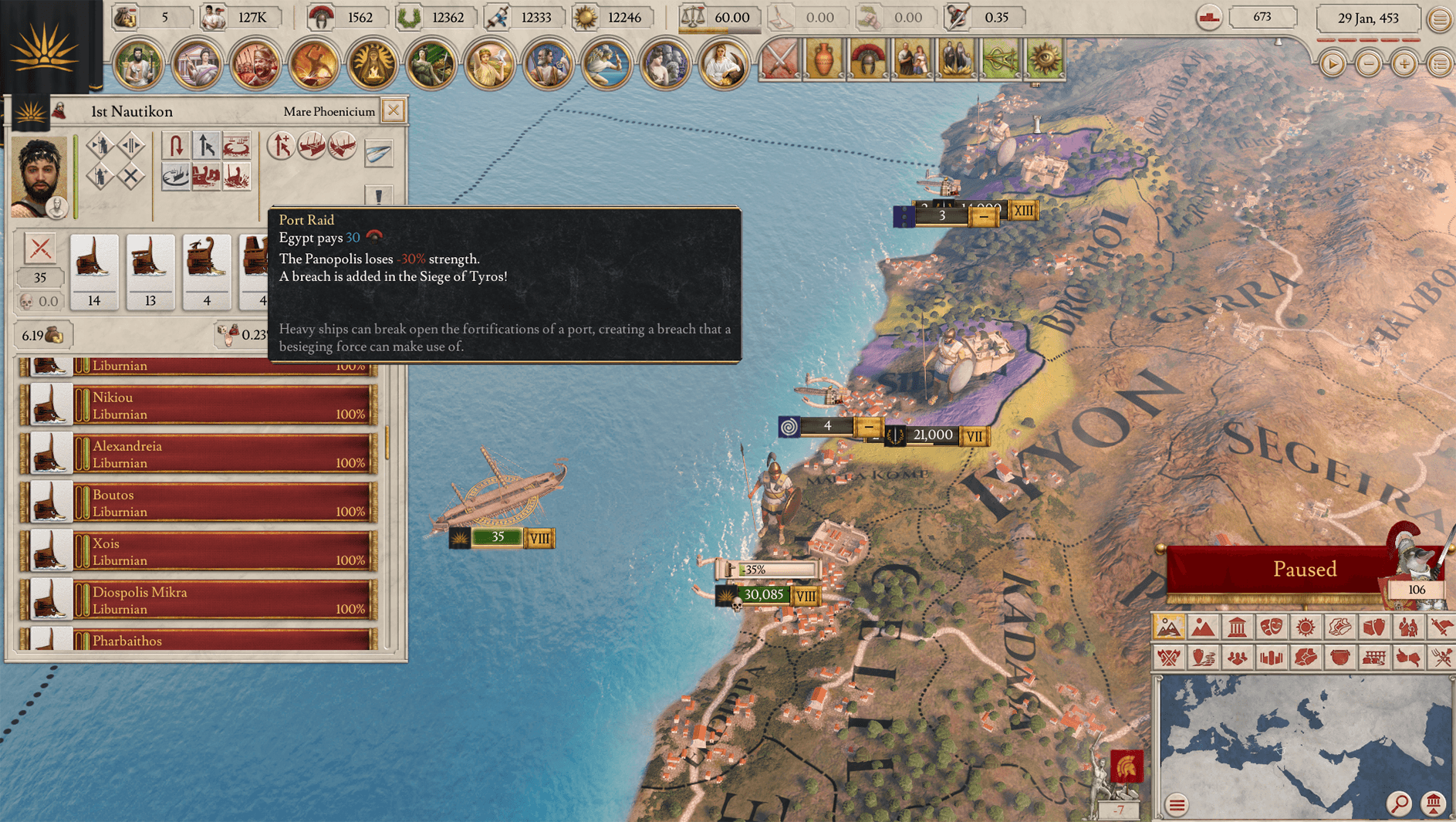
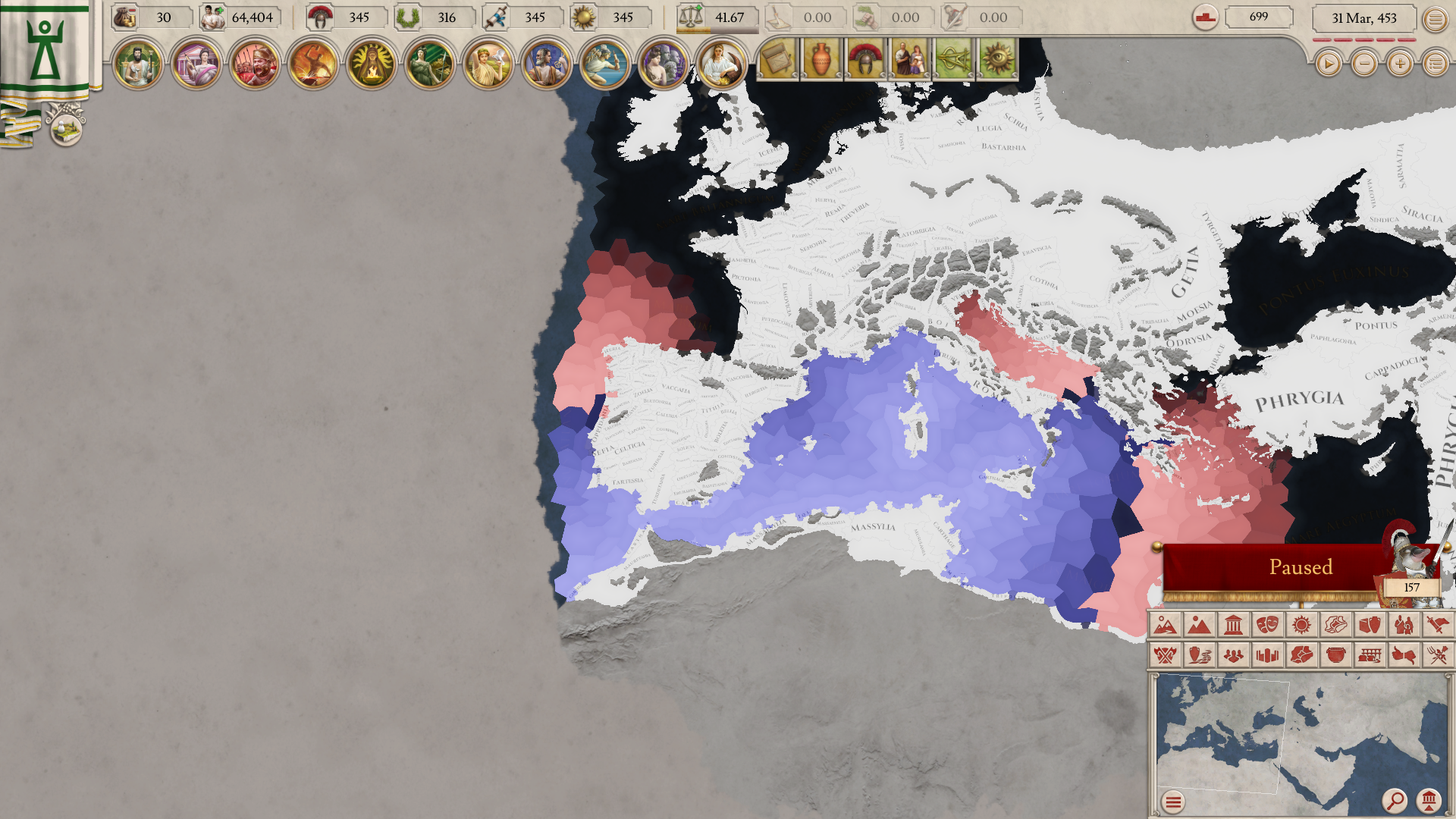
(debug mapmode screenshot to illustrate the extent of range)
All countries will now have a naval range, calculated from their closest owned port. While naval range will be somewhat forgiving ships in navies that go outside of their naval range will take heavy attrition.
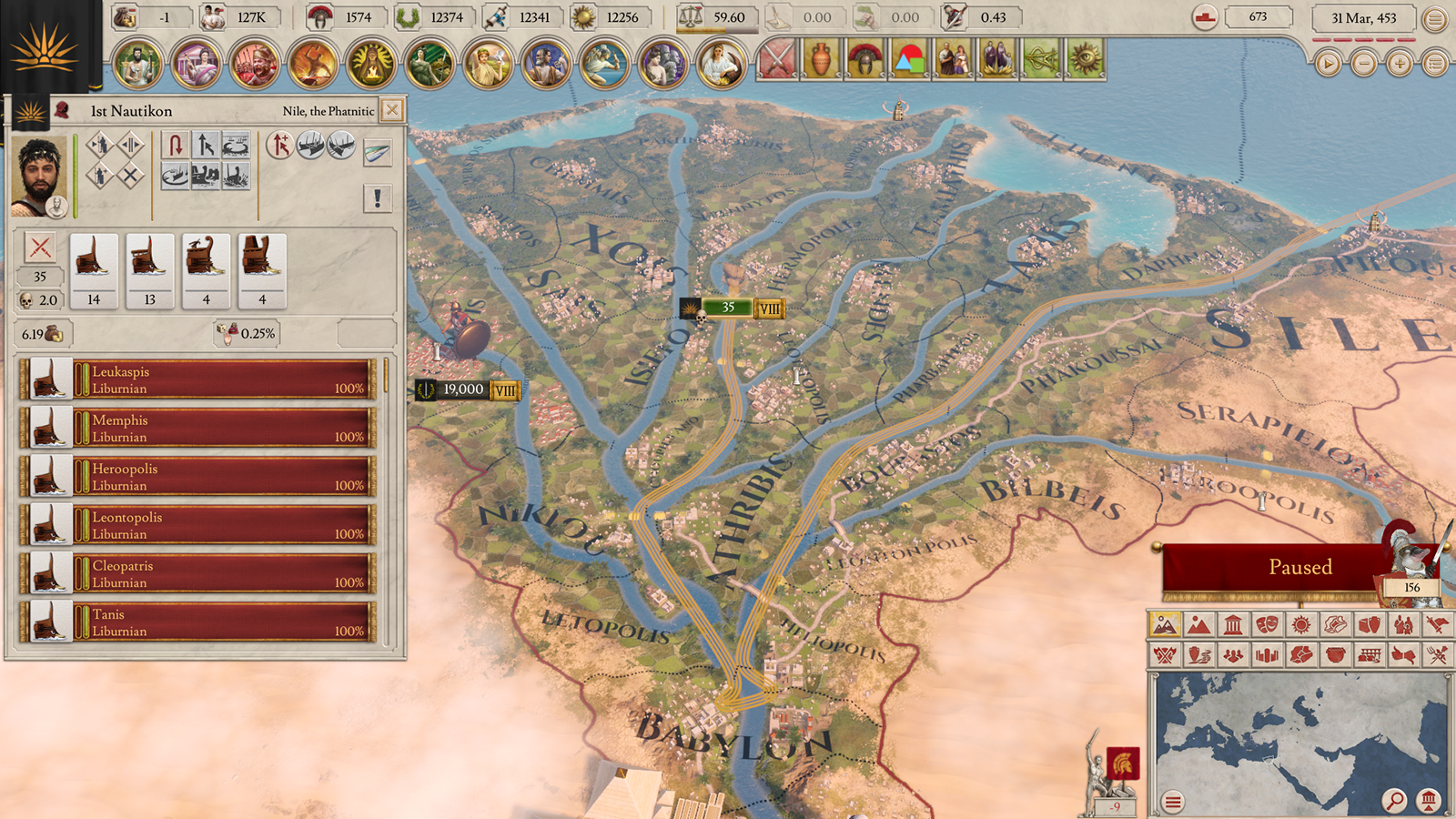
(WIP screenshot of navigable rivers, these rivers will have a different look to more clearly show them as navigable though they do not right now)
While most rivers would not have been fit for the galleys of this era to make much use of them some rivers will now be navigable. For land units such a river will have to be crossable at fording points (similar to straits). Land provinces adjacent to a great river will also have an increased population capacity (more on that in a later diary).

(Screenshot of naval terrain in the simple terrain mapmode)
Not all sea areas are created equal. In Pompey patch there will be 3 different terrain types which also have an effect on which ships are more efficient there and in some cases may confer a defender advantage.
We also want it to have a stronger relation to how naval battles were fought and theorized in the era, and make it possible for navies to play a role in projecting your military ability overseas, as was done by the successor commanders such as Demetrius Poliorcetes. If you want to spend the resources on it you should be able to build a naval force adept at capturing islands and ports which should be especially useful in the Aegean. Making maintaining a navy more meaningful both offensively and defensively.
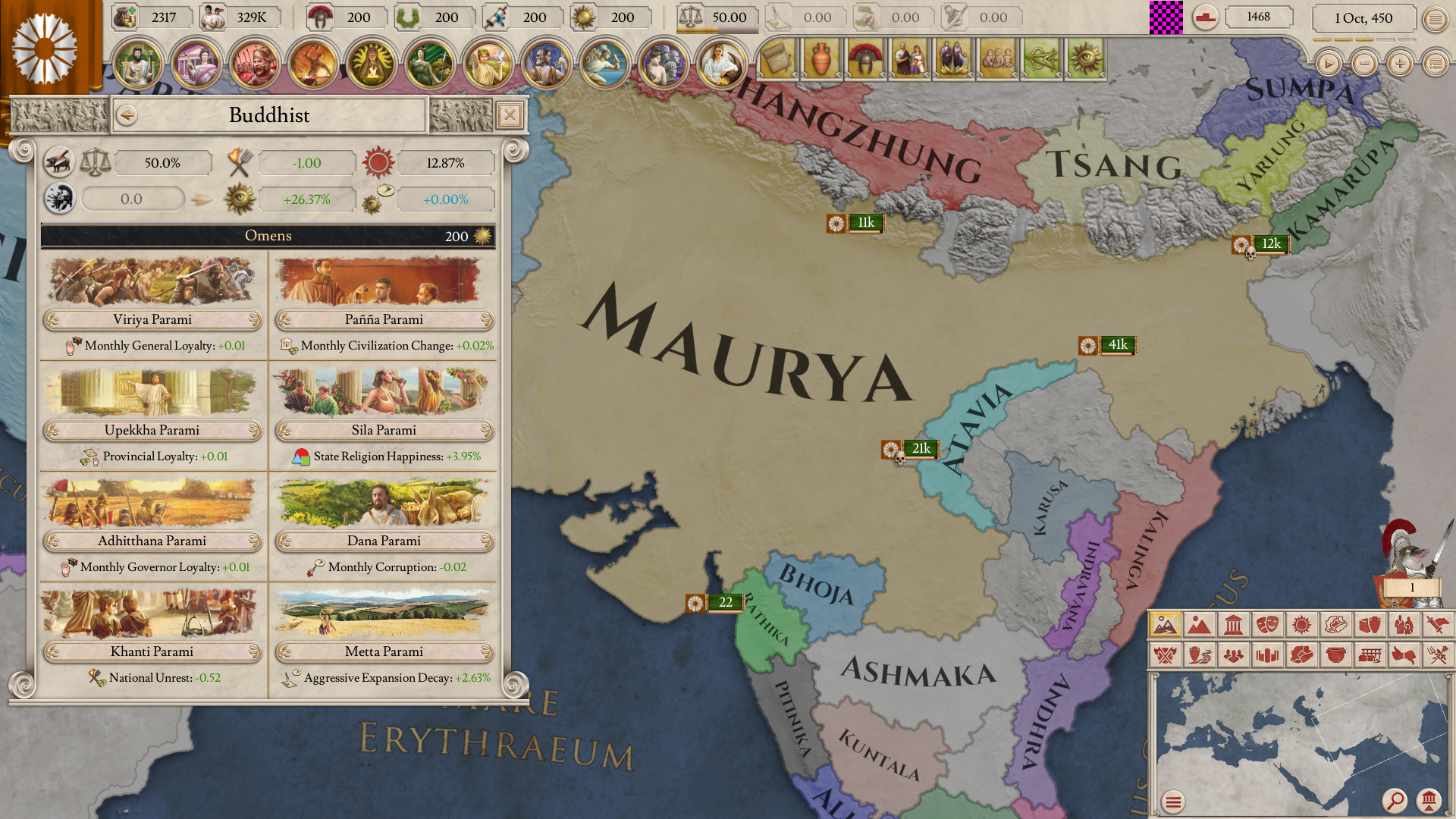
(Buddhist Omens for a Mauryan empire with very low Religious Unity/Omen Power)
As was mentioned in Johans Design Corner post yesterday another thing we want to achieve in the Pompey patch is to give more variety in how different countries play. One of the things we will be doing to achieve this is the addition for base country bonuses for religions, so a Tuistic state will for instance have an easier time migrating their pops.
The other part of it is we have implemented different Omens depending on your religion and culture. Roman and Greek Omens will no longer be identical in what they do and further removed religions such as Kemeticism or Buddhism will have a completely different set of omens to choose from.
The system, which is fully moddable, will also support special cases. Some countries will also have access to their patron deities for omens, as long as they stay with their native religion.
Egypt will also have different Omens depending on if they adopt the Serapis cult or if they stay with their traditional greek pantheon, but the Serapis omens are also different from the ones native Egyptians have access to.
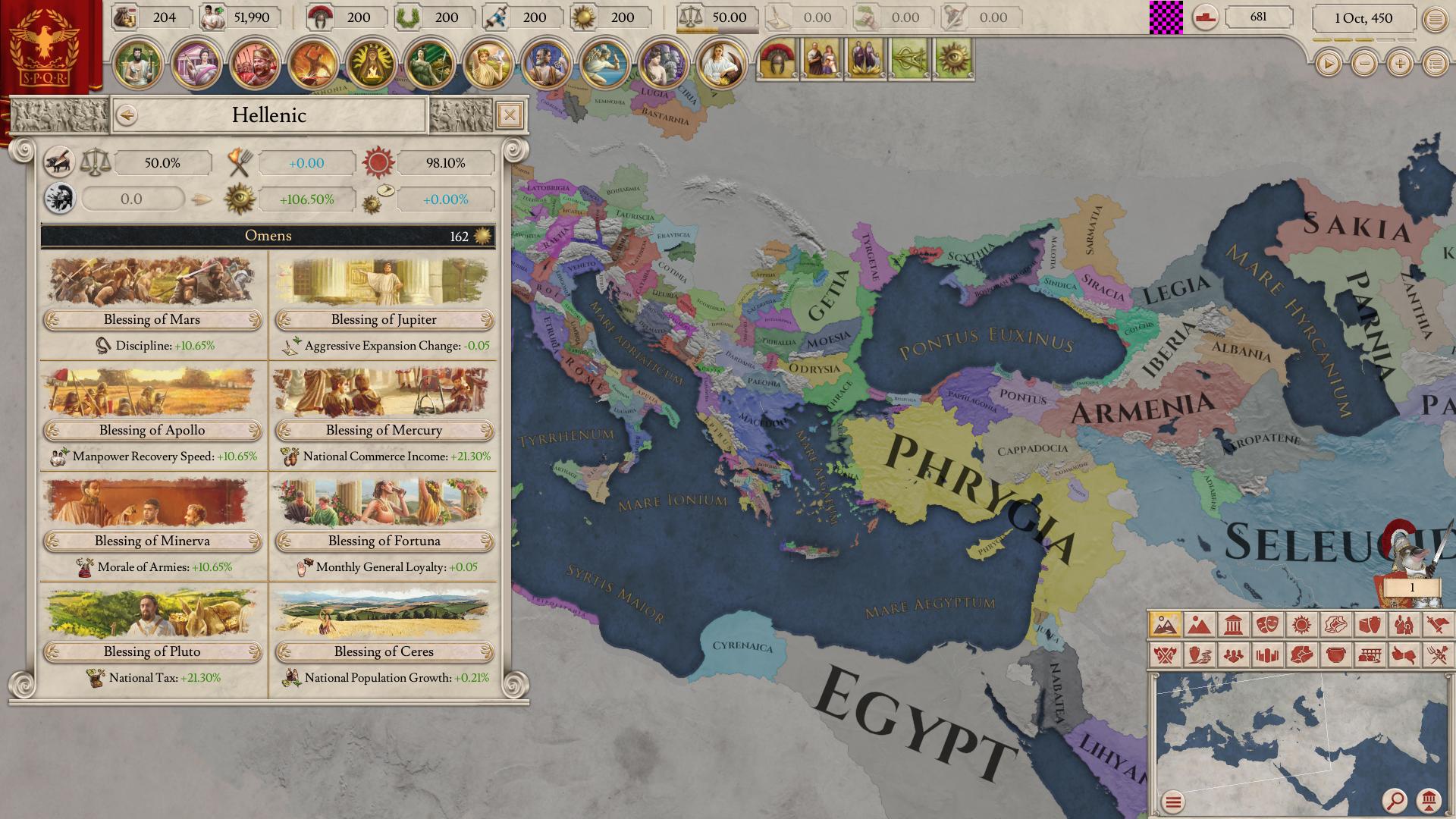
(Current Roman Omens - more familiar in many ways than the ones for Buddhism)
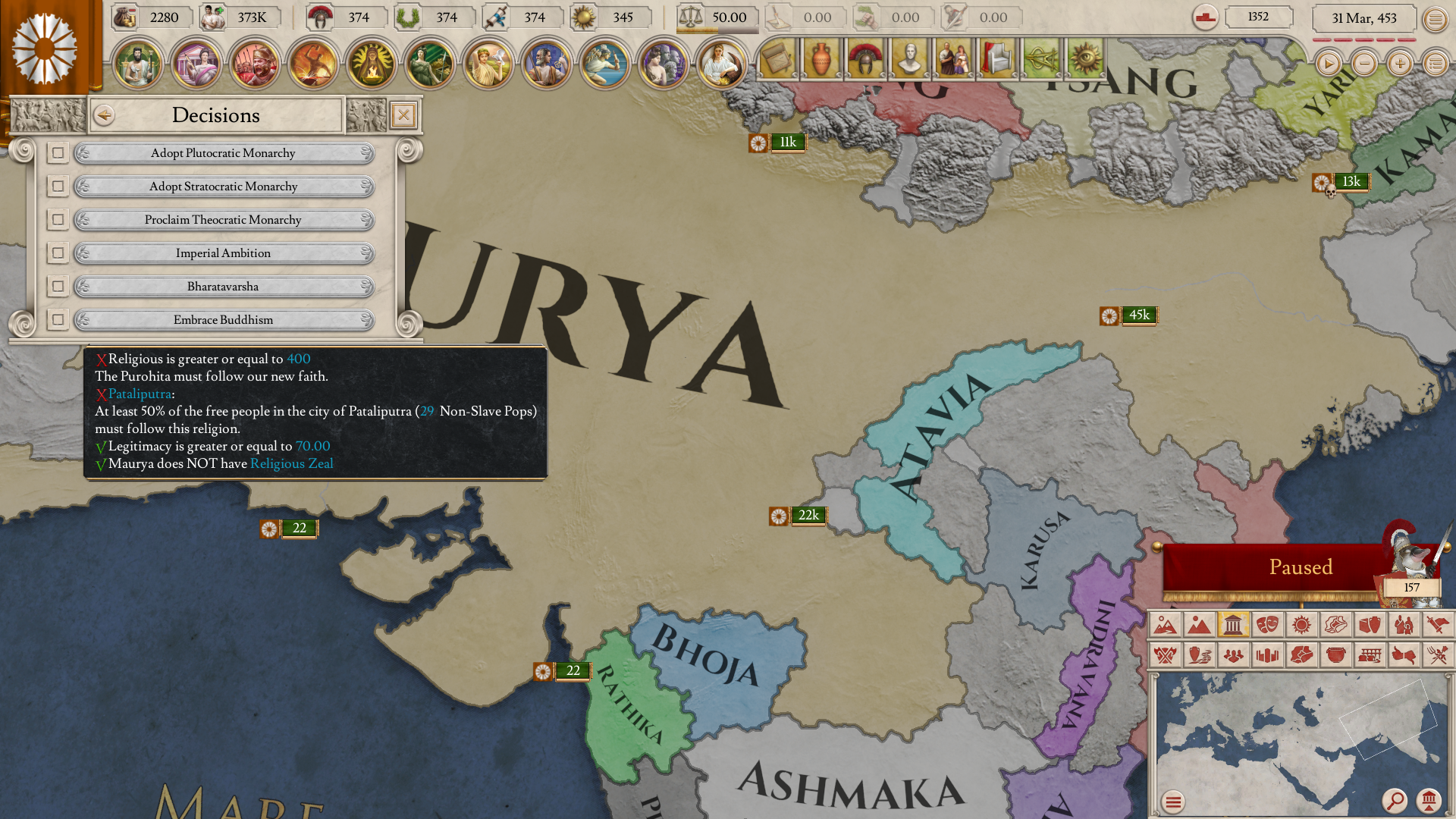
On release only a handful of countries (mainly the Dharmic countries, Bactria and Egypt) could easily switch their country religion. With religions now being more different a more generalized approach has been taken to changing state religion, especially as a number of countries in this era did adopt a foreign religion.
As long as you have at least one character in your country of a foreign religion you will be able to see what it would take to change to that characters religion. The requirements currently are: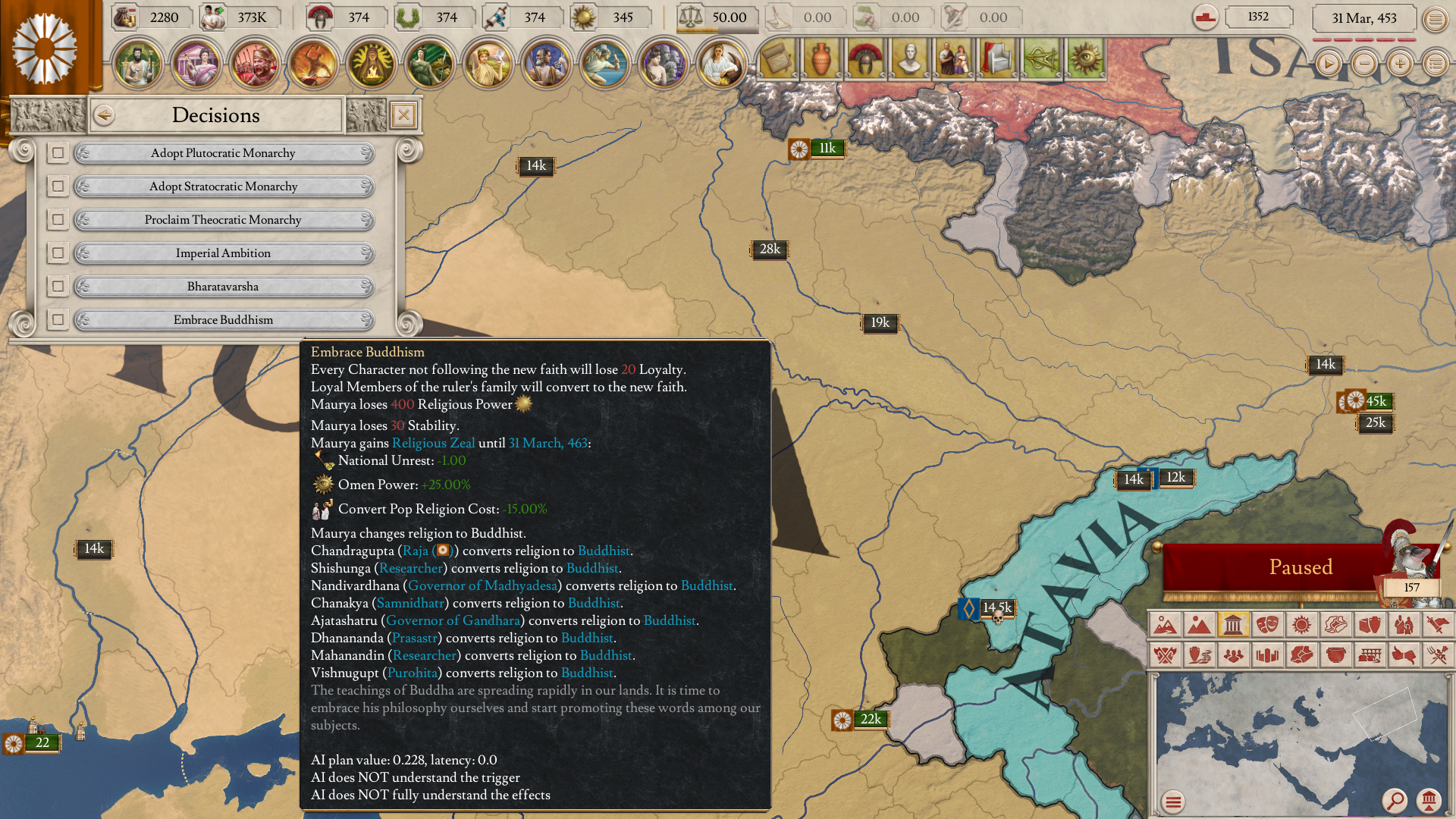
The effects of switching religion can be far reaching, so it is not always a decision to be taken lightly however.
--- Go here to read the original post, and to interact with the developers
Hello and welcome to this development Diary for Imperator: Rome!
This will be the first diary where we go into more detail about what will be in the 1.1 Pompey patch. Today I will be talking about some of the changes coming to navies, and things we are doing to diversify religions. As always with development diaries any numbers should be seen as temporary and are subject to tweaking :)
Navies in the Imperator era
Unlike Land combat , Naval combat in Imperator: Rome at release was in many ways inherited from its predecessor, EU: Rome. That system builds on ships having a chance of ships targeting other ships and dealing damage to them, sometimes even being able to deal damage to their own friends. The EU: Rome system also had only one type of ship, with modifiers representing the differences in naval design as well as tactics between the various parts of the map, most notably the discrepancy between naval philosophy between the eastern and western Mediterranean.While functional, especially for small engagements, we felt this system did not adequately reflect the realities of Hellenistic and Roman naval combat. What were these realities then?
Detailed accounts of naval battles from the era are actually somewhat sparse. Historically navies were made up by a great variety of different types of ships, with different roles. Normally ships from this era are classified by the number of rowers in one section used to propel them. A three (or Triere) is bigger than a two but smaller than a six (Hexere) and would be used for different purposes.
A directed naval battle would often involve galleys forming a line of battle, with the goal of preventing the opposing side from forcing through it. The primary ways for ships to engage were bombardment using arrows and artillery, boarding and ramming. Heavier ships would generally be taller, and harder to board. Ships heavier than 2s or 3s would also generally be Cataphract - covered - to protect from arrows.
Over time ships would grow bigger and bigger, especially in the confrontations between the big and very rich successor kingdoms in the eastern mediterranean. In the western mediterrenean ships would never be as big and with the ascendance of the Roman Empire the custom to build the bigger ships would be forgotten, with the battle of Actium generally being regarded as the end of the Big ship era.
At the start of our game however, and for most of the timeline the trend in the east was to build greater and greater ships, with some truly huge galleys seeing the day of light. The use for these enormous ships (with 10 sections of rowers or more) remains a point of discussion to this day, William M Murray argues that these behemoths of the sea were more useful for siege craft, used for naval assaults on the many ports of the Aegean, the Levant and Asia minor. Their big marine attachments, huge and very heavy high quality rams (a modern laboratory test concluded that the heavier rams in use in this era are impressive even in the light of modern engineering) used to capture ports, by forcing through floating barriers, as well as carrying full siege engines and catapults on board. The various ways to do the latter was something greek navies specialized in general in, with manuals written at the time for how to best conquer or defend a port by sea.
The super heavy ships (which in Imperator is considered to be anything above 8 sections of rowers) were never extremely common, but they did have a given place in the navies of the east and we have wanted to include them and their role, and so our rework is inspired by Murrays work.
Ships & Naval Battles

To better cover the variety and uses of navies will be forming a line of battle. As on land there will be a first row, a second row, and a flank. Ship types will be broken into 3 categories, and individual ship types will have strengths and weaknesses. Mainly the goal is to allow different roles for light and medium ships, based on their usage in the era.
Light ships have high maneuver, allowing them to target opposing ships much further from their position in the line of battle, and can deal more morale damage. Medium ships have less maneuver range but are instead more resistant to damage. The Wood trade good will now be considered to represent access to great amounts of high quality ship building wood and no longer be necessary for the lighter ships, since these should generally be buildable by the wood that would be available in most cities even if it was not their primary export. The medium ships however still require access to wood, and importing wood helps the quality of all ships produced.
Heavy ships (8s and 10s) will have a very limited maneuver (with the 10s just able to target the ship directly in front of them). While they can deal a great deal of strength damage, and probably easily sink any given ship in front of them, they are likely to be swarmed and sunk or even captured if fighting without support against a great number of lighter ships. Heavy ships will however have access to 3 unit abilities (more on that below) and since their niche use was more common in the eastern mediterrenean they will require unlocking via military traditions. Traditions that do not unlock heavy ships will instead strengthen the use of lighter and medium ships.
Lastly when possible ships will make use of cultural names, a Greek bireme will for instance go by the name of Lembos while an Illyrian or even Roman will be called a Liburnian.

The Ship Types:
- Light Ships: (High maneuver and Extra Morale Damage dealt, useful on flanks and possibly in first row) - Does not require Wood.
- Liburnian: Uncovered Bireme. Cheap. Very light ship. Very quick. Used by Pirates near our start but is later one of the main Roman war vessels.Deals low damage against all but has Extra Morale Damage dealt. 6 Maneuver allows targeting ships far away in battle.
- Trirere: Could historically be covered or uncovered. Light ship but heavier than the Liburnian Biremes. Also very Quick. A bit more expensive and takes more damage than the Liburnian. 4 Maneuver.
- Medium Ships (Fours &, Fives, Sixes & Sevens) - Better staying power but much slower. Historically these are ships that would go prow-to-prow. Much more efficient at both Ramming (strength damage) and Boarding. Vulnerable to the sides against lighter ships. Requires Wood.
- Tetrere/Trihemiolia: Cataphract with Four Rows. More costly and for a long time the standard ship in any navy.Does not excel at anything but is also not bad at anything. 3 Maneuver.
- Hexere: Cataphract. 6 Rows. Much Slower but still in widespread use for much of the era. Extra Strength Damage dealt 1 Maneuver.
- Heavy Ships (Eights, Nines, Tens up to Sixteens and Forties) Extremely expensive. Huge Rams, fitted with Catapults and siege weapons. Vulnerable to being isolated and attacked from many sides. Stopped being used entirely around the end of our game but during the greek era could make up as much as 30% of a fleet. Requires Military Traditions to unlock.
- Octere: Heavy and Expensive. The warelephant of the seas.Takes less strength Damage. Deals more damage against all. 0 Maneuver (so cannot engage unless opponent is directly in front of it).
- Mega Polyreme - Extremely Expensive. Represents ships of size 10 and up. Withstands more strength damage. Can create a breach on a seaside fort. 0 Maneuver.

[h1]Capturing ships
[/h1]
When a ship reaches 0 morale while not yet being at 0 strength there is a chance it will be captured. Capture chance will be based on the type of ship that was targeting the removed ship and the removed ship itself. Mediums and heavies have slightly higher chances to capture lighter ships, but since lighter ships deal more morale damage they will get more chances to capture ships overall. A fleet of only light ships is far more likely to take a higher number of prizes in any given battle.
A captured ship is still removed from battle but will be added to the opposing navy that the capturing ship belonged to.
Naval Tactics

With more ship types available the Tactics system is going to be used at sea as well. Depending on your composition different tactics will have varying efficiency. Choice of tactic can also affect how likely the battle is to result in the capture of ships.
Naval Power Projection Unit Abilities:

- Capture Port: Unit ability that can be used by a navy that has 5 Heavy Ships in it. Takes direct control over an unfortified port. Useful for establishing a beachhead before a full on naval invasion.
- Port Raid: Unit Ability that can be used on a fortified port with an ongoing siege by a navy that has one Heavy Ship at above 95% strength in it. Creates a breach immediately. Reduces strength of Heavy Ship by 30%.
- Port Assault: Unit Ability that can be used on a fortified port with 1 fort level by a navy that has one Hyper Galley at full strength in it. Reduces that fort by one level and reduces strength of the Hyper Galley to 20%.
Naval Range

(debug mapmode screenshot to illustrate the extent of range)
All countries will now have a naval range, calculated from their closest owned port. While naval range will be somewhat forgiving ships in navies that go outside of their naval range will take heavy attrition.
Navigable Rivers

(WIP screenshot of navigable rivers, these rivers will have a different look to more clearly show them as navigable though they do not right now)
While most rivers would not have been fit for the galleys of this era to make much use of them some rivers will now be navigable. For land units such a river will have to be crossable at fording points (similar to straits). Land provinces adjacent to a great river will also have an increased population capacity (more on that in a later diary).
Naval Terrain

(Screenshot of naval terrain in the simple terrain mapmode)
Not all sea areas are created equal. In Pompey patch there will be 3 different terrain types which also have an effect on which ships are more efficient there and in some cases may confer a defender advantage.
- Open Sea: No combat modifiers
- Coastal Sea: Used in archipelagoes and in areas adjacent to land, defender advantage.
- River Terrain: Navigable rivers will favor the defender and greatly favor lighter ships.
We also want it to have a stronger relation to how naval battles were fought and theorized in the era, and make it possible for navies to play a role in projecting your military ability overseas, as was done by the successor commanders such as Demetrius Poliorcetes. If you want to spend the resources on it you should be able to build a naval force adept at capturing islands and ports which should be especially useful in the Aegean. Making maintaining a navy more meaningful both offensively and defensively.
Omens & Religions

(Buddhist Omens for a Mauryan empire with very low Religious Unity/Omen Power)
As was mentioned in Johans Design Corner post yesterday another thing we want to achieve in the Pompey patch is to give more variety in how different countries play. One of the things we will be doing to achieve this is the addition for base country bonuses for religions, so a Tuistic state will for instance have an easier time migrating their pops.
The other part of it is we have implemented different Omens depending on your religion and culture. Roman and Greek Omens will no longer be identical in what they do and further removed religions such as Kemeticism or Buddhism will have a completely different set of omens to choose from.
The system, which is fully moddable, will also support special cases. Some countries will also have access to their patron deities for omens, as long as they stay with their native religion.
Egypt will also have different Omens depending on if they adopt the Serapis cult or if they stay with their traditional greek pantheon, but the Serapis omens are also different from the ones native Egyptians have access to.

(Current Roman Omens - more familiar in many ways than the ones for Buddhism)
Converting Religion

On release only a handful of countries (mainly the Dharmic countries, Bactria and Egypt) could easily switch their country religion. With religions now being more different a more generalized approach has been taken to changing state religion, especially as a number of countries in this era did adopt a foreign religion.
As long as you have at least one character in your country of a foreign religion you will be able to see what it would take to change to that characters religion. The requirements currently are:
- A majority of the free (non slave) pops in your capital must follow the new faith.
- In a Republic your senate must approve.
- In a Monarchy you must have at least 70 legitimacy.
- In a tribe the clan leaders must approve.
- Your High Priest, Pontifex, or equivalent must follow the new Religion.

The effects of switching religion can be far reaching, so it is not always a decision to be taken lightly however.
- All character that do not already follow the new faith will lose 20 loyalty. The ruler and loyal members of their family will also convert.
- The 6 most prominent loyal characters in the country will convert.
- For a period you will enjoy more efficient religious conversion to help establish the new faith (as long as this bonus is active you cannot change your faith again).
--- Go here to read the original post, and to interact with the developers
[ 2019-05-06 13:38:53 CET ] [Original Post]
Minimum Setup
- OS: Ubuntu 20.04
- Processor: Intel iCore i3-550 or AMD Phenom II X6 1055TMemory: 4 GB RAM
- Memory: 4 GB RAM
- Graphics: Nvidia GeForce GTX 460 or AMD Radeon HD 6970
Recommended Setup
- OS: Ubuntu 20.04
- Processor: Intel iCore i5- 3570K or AMD Ryzen 3 2200GMemory: 6 GB RAM
- Graphics: Nvidia GeForce GTX 660 or AMD Radeon R9 380
GAMEBILLET
[ 6415 ]
FANATICAL
[ 7146 ]
GAMERSGATE
[ 3628 ]
MacGameStore
[ 4850 ]
FANATICAL BUNDLES
HUMBLE BUNDLES
by buying games/dlcs from affiliate links you are supporting tuxDB

